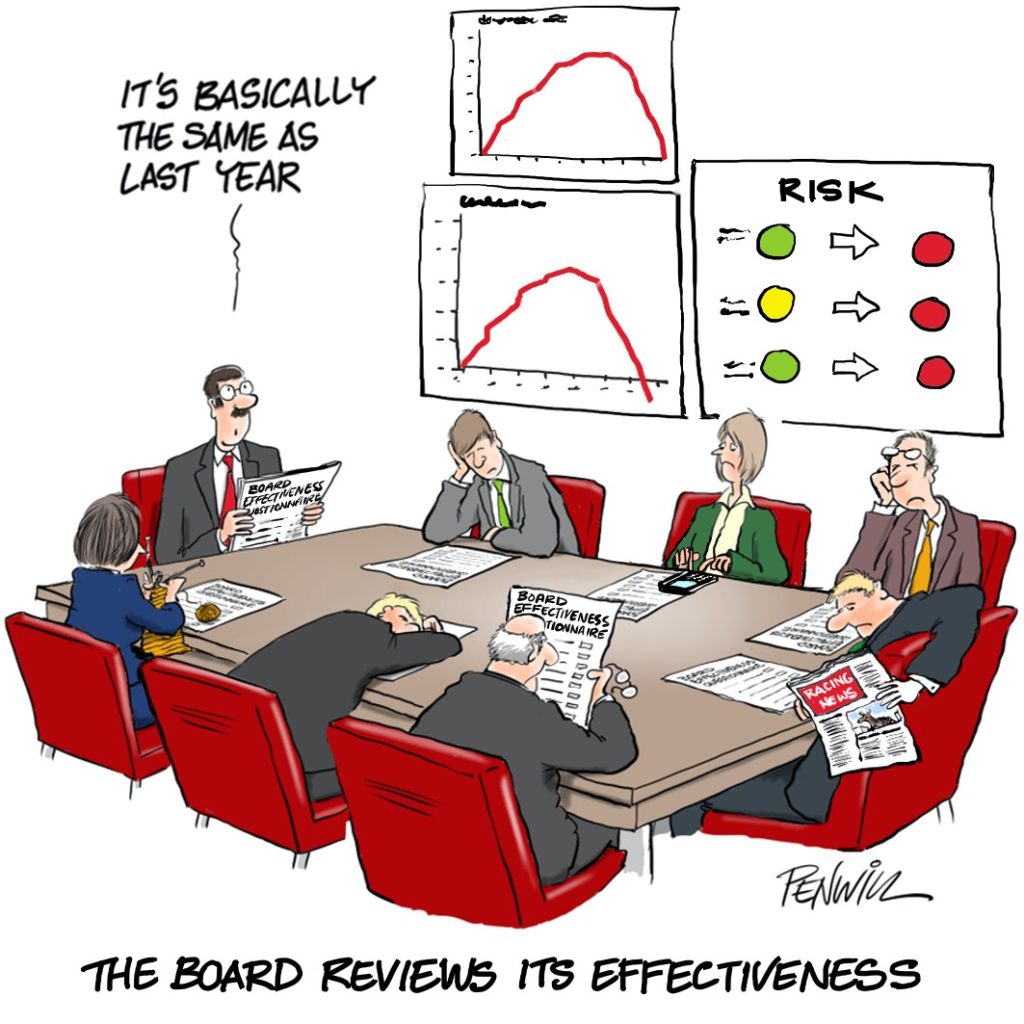Glaring Indicators of a Board’s Current & Future Success
(Originally appeared in the August 12th, 2020 ‘Across the Board’ publication, a Board Director, Board Advisor, C-Level, and Business Leader publication reaching 26,500+ exceptional business leaders in over 70 countries with articles focused on leadership, strategy, and governance topics – sign up here)
Many organizations and their Boards have the ability to do well, even flourish, during periods of global economic positivity and calm social times. Revenue growth, increasing profits, and a positive future outlook are the desire of most businesses. However, these one-dimensional measuring points have a sneaky way of cloaking cracks in the foundation, only to be realized when major risk events occur. Many Boards have once again relearned this the hard way in recent times with the COVID-19 pandemic coupled with social unrest happening around the world. During the quick move from one end of the spectrum to the other, countless Boards have been caught off guard and relegated to the reactive realm of explaining ‘what happened TO them’ instead of ‘what happened FOR them.’
However, what if there was a reliable way to predict beforehand which Boards would immediately accept their predicament, reference their detailed goals and planning, and quickly adapt to adversity in support of their organizations vs. which Boards would succumb to a mountain of perceived ill fortune, subsequently failing their organization, stakeholders, and fellow Board Members? I know, this sounds too good to be true …but is it possible?

Over the past decade, I have advised and been a trusted consultant for hundreds of public, private, and nonprofit Boards. When engaging with these Boards within a specific offering or focus area, the level of detail attained typically allows for an accurate evaluation of the Board’s effectiveness and efficiency. Even when performing high-level Board Observer Services, an option for organizations and Boards looking for ‘quick wins’ and for fast input on needed remedial action, especially prior to engaging in strategic or larger-scale initiatives, there are obvious indicators that can act as accurate predictors of a Board’s current and future success probability. These simple indicators, or ‘observables,’ can serve as a manageable starting point for Board improvement initiatives or can be leveraged by Board Candidates when deciding if a Board will be beneficial (and fulfilling) to join.
Observable #1 – Board Structure: How a Board has been constructed, or as I like to say, “architected,” has much to do with its effectiveness, efficiency, and success. This is because proper Board architecture considers multiple facets of a Board’s makeup, not solely each individual member’s area of professional expertise or experience. A properly architected Board should have equal focus on its a) ‘Sphere of Influence’ (vertical considerations such as leadership acumen, operational experience, and expertise coverage), b) ‘Planes of Congruence’ (horizontal considerations such as personality trait balance, strategy and governance acumen, emotional intelligence and mindfulness intelligence (EQ and MQ), etc.), and c) ‘Coverage and Balance’ (ensuring the depth and overlap of important expertise to allow for identification and meaningful deliberation / conclusion). There is much to know here. For a full overview, pick up a copy of my book, ‘Across The Board – The Modern Architecture Behind an Effective Board of Directors.’
Observable #2 – Board Interaction: Communication is key for a successful Board. Much can be deciphered when observing the interaction and communication style of a Board by its individual members. Are Board Members mindful of one another? Is there allowance for opposite viewpoints without fear of reprisal? Is there too much emotion clouding otherwise sound decision making? Is there empathy? Are all Board Members open to voice their opinions? What all of this really comes down to is respect. The most successful Boards are extremely open to discuss and hear all viewpoints without becoming paralyzed at decision time. One of the most indicative qualities to observe in a highly-functioning Board is that of ‘respectful dissent’ – a common example is a Board Member who is outvoted on a voiced preference, but is able to say “I disagree, but I stand by the majority vote of this Board and support the decision 100%.”
Observable #3 – Board Diversity: Diversity on a Board is extremely important, but let’s first get something straight. Inclusion of women and minorities on Boards isn’t about checking the box of racial or sex diversity. Yes, including historically underrepresented populations within the boardroom absolutely makes for a more equitable workplace at all levels, but let’s not overlook the main reason of why diversity is important in decision-making and leadership – ‘diversity of perspective’ leads to ‘diversity of thought,’ an extremely important quality for Boards to possess. Diversity of perspective leading to diversity of thought leading to well-informed and holistic decisions is the goal. Boards that embrace diversity send a clear message that they are open to change and truly value varying viewpoints – all of which supports sound decision-making and lowering of risk.
Observable #4 – Board Dedication: Actions speak louder than words, so when it comes to a Board Director’s oath of ‘duty of care,’ ‘duty of loyalty,’ and I would add ‘duty of obedience,’ look for the physical manifestations of these promises. Is there consistent full attendance of Board Members at meetings? Is there too much delegation of strategic or governance-related items that could disconnect the Board from reality? Will the minutes of the current Board meeting sound very similar to the previous Board meeting (meaning not much was accomplished in between)? Has the Board’s verbal dedication to goals actually converted into physical accomplishment? Is the Board putting in the effort to think past simply shareholders and include stakeholders’ concerns, as well? In many instances, Board Directors underestimate the time it takes to properly perform their duties on a yearly basis, not to mention during times of crises. Positive outcomes do have a direct relationship to available time dedication in most cases, so the balance of involvement and time commitment go hand in hand.
Observable #5 – Board Learning Environment: Boards as well as individual Board Members have a continuing education priority that is inherently a requirement of their positions. Does the Board incorporate continuous learning topics into its meeting agendas? Do the individual Board Members pursue advanced education and certifications in the Board vertical on their own time and money? When a specific challenge is encountered, are experts in the field brought in to present at a governance level? Thinking that once Board Director status has been reached and no further education is required is a defunct belief. The fact is, the amount of learning and required education for Board Directors increases exponentially to remain effective and properly serve an organization.
Take the time to perform an honest evaluation of these 5 Board Observables and know that each poses a threat to the Board’s effectiveness and efficiency. You will likely find, as I have, that they commonly are an entry point and microcosm of larger issues demanding the Board’s attention. Have the courage to propose and make changes. It may just prove to be exactly what your Board and organization needed.

 5.0
5.0 





















